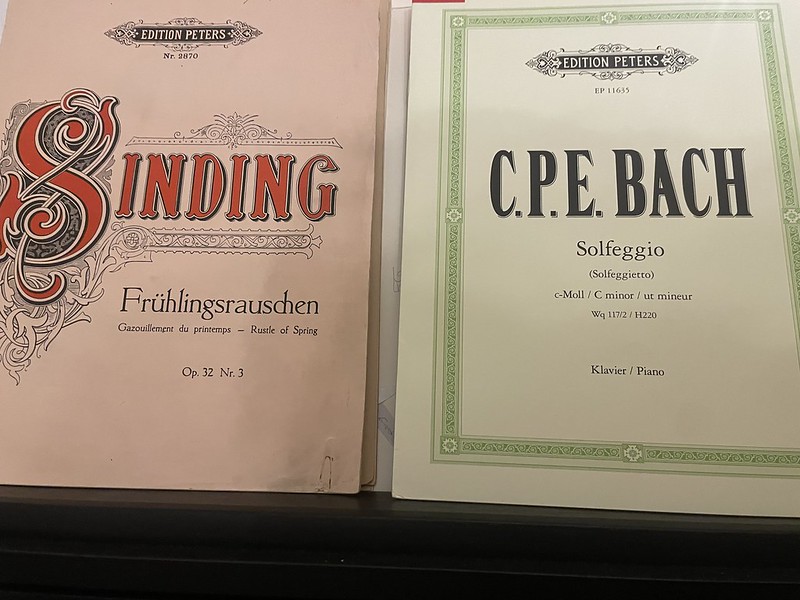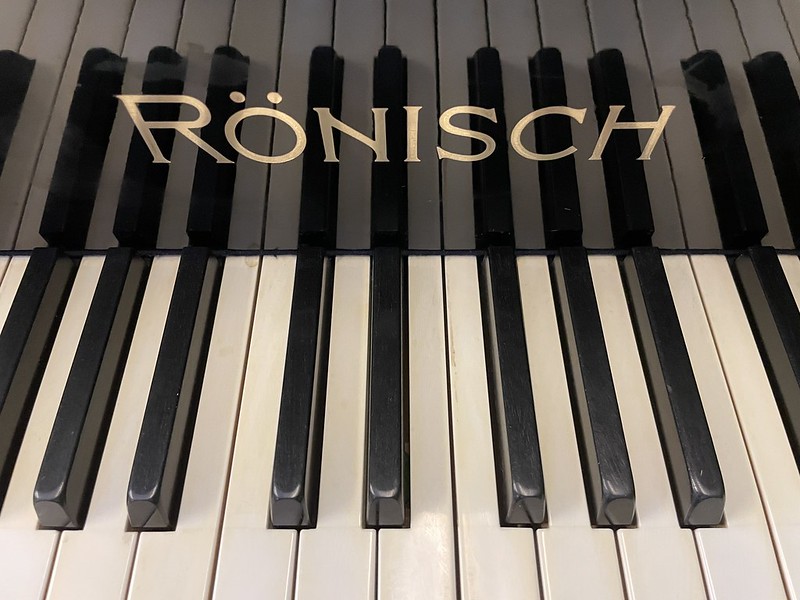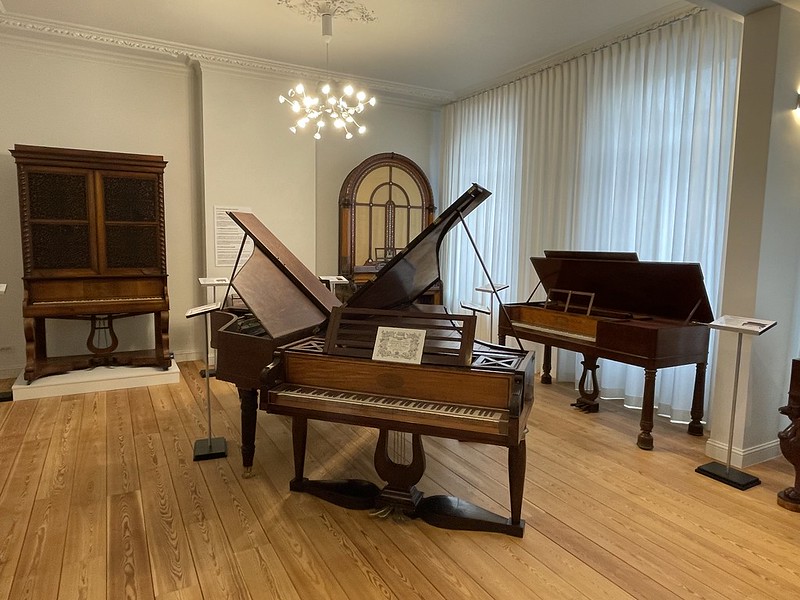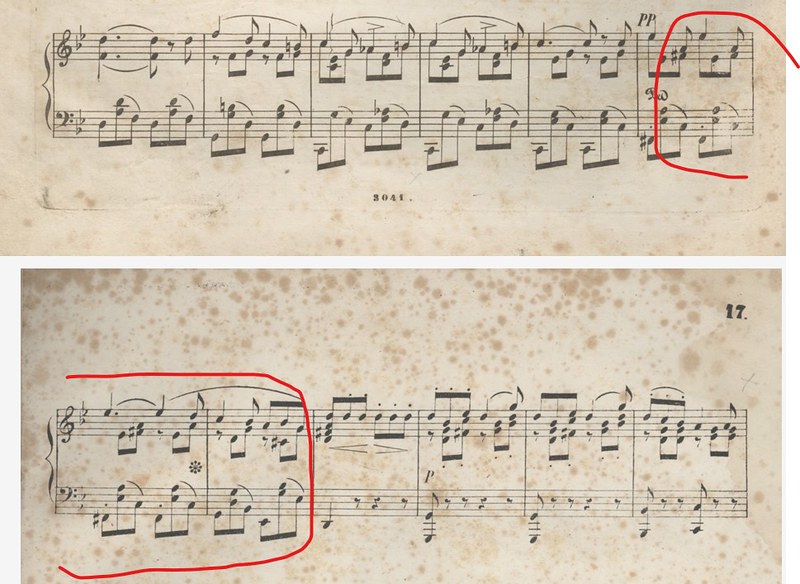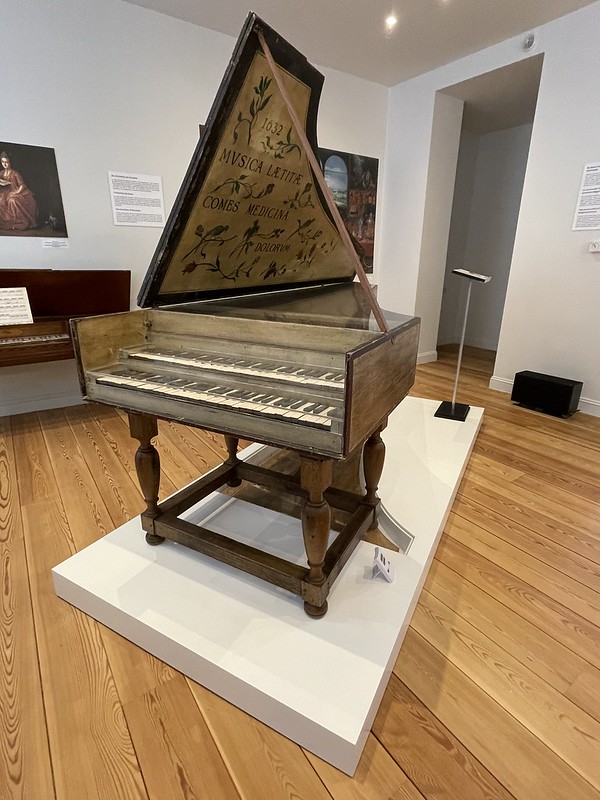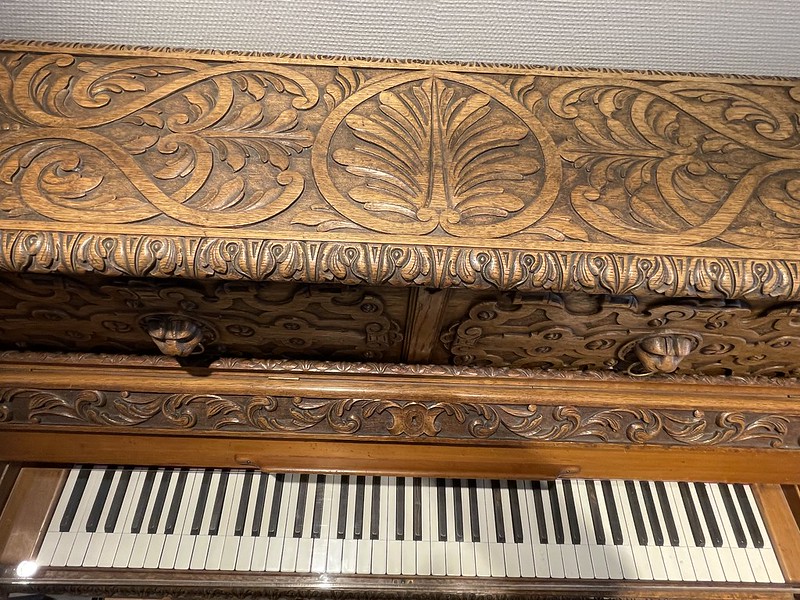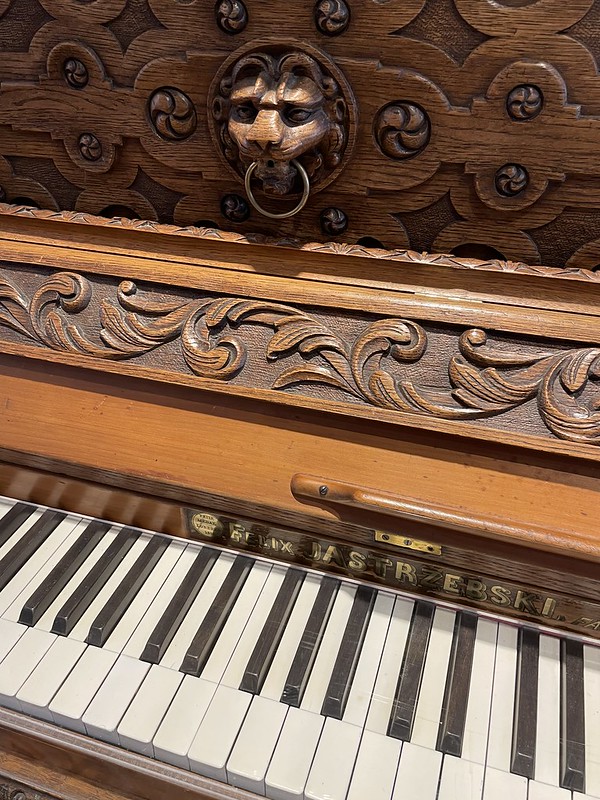I haven’t had a look yet but apparently Bosendorfer has arrived on Pianoteq. I disassembled the crazy cabling set up I had for that a while back so I hope I can reassemble it all to see what it sounds like.
Category: pianos in general
Gifts for the pianist in your life
It’s 17 December. I suppose I should have done this a few weeks ago. Sorry about that.
Anyway, there are just a few ideas to think about if you are stuck. I’ve no handy pictures. When I do this next year I’ll do it better.
A piano
Most pianists already own a piano but if you are a multibillionaire with a nice big house, then Steinway Ds or Faziolis are always popular. If you are not wealthy and your pianist already has some sort of piano, then the chances are this is not your market segment.
Lego do have a grand piano model which is several hundred euro worth of bricks. You may want to consider it.
Annique Gottler has a grand piano model on a shelf in her studio. I covet it. I have no idea what it is but as she is a Boston ambassador I’m going to guess it might come from Steinway.
Sheet music
The safest bet here are vouchers for your pianist’s sheet music dealer of choice. There may be several. Credit for Henle Digital is always useful too but difficult to do in secret.
The cotton hardback editions of Rach and Bach are an attractive addition to any bookshelf. I don’t recommend Bartok in any shape or form. If your pianist is a teenager, consider books of computer games music as well.
But vouchers. Vouchers are always possible
Concert tickets
Or vouchers. Most concert halls do them. Vikingur Olafsson’s Goldbergs are the hit tour of the minute. Check out your local options or plan a trip to, say, Verbier, the Elbphilharmonie. Are they notably partial to a particular concert pianists like Martha Argerich or Danil Trifonov?
Verbier’s schedule is out on 15 Jan, and public sale starts on 29 Jan. Not sure what will be available but let’s put it this way. I would love to have been in the room for this.
Metronomes
There are Metronome apps on both the Apple and Android stores. But there are battery operated little beauties (I bought one the other day) and then, your budget can cover a multitude with the Wittmer or antique ones. I’m conflicted between a turquoise or a ruby red little Wittmer. Ebay is full of antique wooden pyramids with brass fittings. If your pianist has a youtube channel, check their styling. A 19th century brass thing is going to look out of place in a cold modern black and white studio.
Digital Services and online teaching
You can get lifetime subs to ToneBase and Josh Wright Piano. I’m not going to recommend one over the other and these are high end gifts anyway. But there are some pianists who give private lessons on line lessons. Youtube premium for ad free watching of Garrick Ohlsson lectures might also be an option but that is a monthly commitment.
Absolutely anything which has a grand piano printed on it
- Cups
- Totebags
- Scarves
- Hats
- Brief cases
- Stickers for their laptop
- Notebooks. The Beethoven Paperblanks is still knocking around in a few shops. I regret missing the Chopin and Schubert ones.
- Earrings and other jewellery
- Rulers
- Pens
- Blue print of a Steinway
- Books such as The Piano Shop on the Left Bank, The Lost Pianos of Siberia.
A trip to Trier
I was in Trier for the first time in a few years at the weekend. It was a great weekend and since it was Trier I took the opportunity to visit two grail shops; one being Musikhaus Kessler, a place where I bought quite a lot of sheet music when I was living in Luxembourg. I also bought quite a few bits of music giftery – they are very good for that.
Anyway, my current music shopping list included the Sinding, already mentioned in previous entries, and Solfeggio by CPE Bach. I’ve since discovered that Solfeggio has previously been a Grade 6 piece for ABRSM (so I could have used it as the self selected piece for my currently stalled Grade 6 piece). It’s been mentioned a lot in r/piano and it sounds nice. So yeah, on the learning list it went, and also, not like everything on my learning list, it also made its way onto the sheet music shopping list. The Sinding was really more luck – they don’t have a lot of second hand stuff but that was there, and more importantly, this is the edition that was there; a lovely older imprint. I really wish Peters would use more beautifully engaged title pages again. I had been looking for this edition on Ebay (there were a few) but lo, here it was in my hands, and subject to being bought by my credit card. This made me happy. I haven’t started it yet although both pieces are sitting on my piano stand at the moment. This leaves only a piece of Sibelius, Opus 76.2 on my list. I don’t see many versions of it in print so I think I got it from IMSLP in the end. Incidentally, I signed up for them for a year because they are worth supporting. The current print version that I found on Stretta did not really appeal to me.
So I would like to accidentally find that too. I didn’t score on Ebay or AbeBooks yet.
The other grail shop – and I really do recommend it to anyone in the area who loves pianos – is Marcus Huebner Pianohaus. It’s about 5 minutes from the main railway station in Trier. It is a lovely piano shop, a major Steinway dealer, and the staff, and Marcus himself are really lovely people to talk to. The last time I was there (before this trip), they had two beautiful Model Ds out. This time, they had a couple of special editions, some Model Bs, some Model Os and a Model C. I played the two special editions. I tried to play one of the Bs but it was already reserved for someone and while it seems irrational, I never do well with pianos that I know are for someone else. It’s better if I don’t know.
The two special editions were a maquette Model O and a silver Model B. I spent a lot of time with the silver Model B and have to say, it’s a beautiful piano to play. It seems similarly priced to a new Model B so if the piano appealed to you and you have the money, the choice between silver and standard wouldn’t be driven by price.
The Model Os felt less light under my fingers, a little heavier. As they are a smaller piano, that would have surprised me. Nevertheless, the piano was a beauty to look at. There’s been the occasional debate of black versus not black – I have mixed feelings. It’s pretty much the case if I were buying a new piano, I would default to black polish. But for the older pianos from the earlier 20th century, the different wood casings are very attractive.
I’m not currently in the market for a piano, although I am always in the market for a Steinway B when I have sorted out an apartment. So the question of whether I would go for the marquette casing is more or less moot. I very much appreciated the opportunity to play the piano though as I don’t often get the opportunity to play unusual pianos.
Marcus Huebner has also his own range of pianos and although I’ve played one in the past, there was not one on display last weekend. This is a pity. I’m privileged in that I have played one of his, and also one of Chris Maene’s straight strung pianos.
In this way, were I ever to be in New York I’d love a trip into the Steinway Vault (see Tiffany Poon here) and the Bechstein Foundation in Berlin which I only recently found out about.
At some point, I must write some notes about special pianos, dream pianos, and our friends of the every day.
A perfect piano
If you take a look at this long indulgent post I wrote the other week on the question of Pianos I have Loved, you’ll see I included a Steinway D in that list.
Well, I will probably never be able to afford one but I now occasionally have access to a Steinway B and I like it rather a lot and at some point in the future I might be able to find space for one in an apartment. It’s the second Model B that I really liked playing – a few more and I’ll assume that like Ds, they are safe to order sight unseen (but let me visit the factory anyway) – I tested one in Steinway Hall in Paris (I love that place but don’t go often enough). In the end I didn’t buy the Ronisch I was looking at (mentioned in that long post) because the current apartment isn’t really suitable for a piano, more for the health of the piano than anything else (it gets extremes of humidity and heat and I didn’t think this was good for a 1930s piano that Rach might have played. Someone else apparently has bought it so it will forever be the one that got away).
So I will set up a savings plan for the Model B and hopefully by the time I have enough money, I will also have a suitably modern climate controlled apartment to put it in. The question is, what am I doing in the interim without a beautiful grand piano? Well, at some point, I came across something called Pianoteq. I have a digital Kawai, a CA59 which I bought during the pandemic (and thus had to wait a long time for delivery) and while I like it very much to play physically, I wasn’t all that lost on the selection of sounds – there are a couple of nice grand piano sounds but for some reason, they didn’t always float my boat (if you have one of those pianos, I like the Warm Grand sound). Anyway, the plus point about having a digital piano is that you can use it as a Midi controller. I wasn’t really in a hurry to go messing with that side of things until I started making recordings on it and figured I should learn a bit more about the capabilities of the piano beyond the on/off switch, the volume control and the sound selecting bit.
Pianoteq is a piece of software developed at the University of Toulouse and it is a physical model of various piano sounds. During the year they released a version for iOS and either an ad popped up in Instagram or YouTube or I saw it mentioned in one of the piano magazines. The reviews on YouTube are sparkling to say the least. A high proportion of people using this software state it is the best piano emulator and they have licensed some sounds not present on my Kawai, curiously enough, the two Steinway Ds (both New York and Hamburg), the Steinway B, a number of C.Bechsteins and some instruments from historic collections. And then some. They allow you to install for test purposes, and kibosh the test system by a) blocking some keys and b) going silent after 20 minutes or so (but you can restart). I had some issues configuring it which may be linked to the Kawai more than anything. Also, I learned that the Bluetooth lag to Apple AirPods is … long.
So my set up, despite cables being connected, is a Bluetooth connection from the piano to the iPad into Pianoteq and wired headphones into the iPad and that works okay for me. There is a very, very, very ickle lag.
What to do I think of it? Well, I bought the software after some testing (so yes, I liked it). I bought the entry level licence plus some additional instrument packs. It’s not exactly cheap but it is a licence rather than a subscription and you can run it on any of your appropriate devices (eg, a Windows machine or a Mac) without having to cough up more. You get two instrument backs with the basic licence which you can choose – I added the Steinway D pack and the C. Bechstein pack, and then I separately added the Steinway B and the historic set which included a 19th century Erard. I really liked that sound testing.
It costs less than an actual Steinway B and so far my Kawai isn’t cribbing about the humidity that I sometimes suffer in the summer. As a stepping stone to my dream piano, it fits my needs. On the downside, even though it does cost less than a Steinway B, there’s an upfront cost. Your mileage may vary on whether you want it or not. For me it has joined the toolset. And I hope it will support some more recordings out to my Soundcloud channel as apparently I can start running things through GarageBand with it.
I used to dream of all this sort of musical freedom when I was 15 years old.
Pianos I have loved
I grew up with an English upright that had, I’m told, been restored before it was bought for my sisters. I decorated it myself when I was about five, using the chimney of my dolls house. It had a handy little nail in it which I could use to make marks on polished wood. I drew a house. I had more faith in my art skills at the age of 5 than I did for the subsequent 40 years. And probably more, let’s be honest.
Anyway. My life was upright pianos for most of my childhood. My teacher had an equally old piano; I think it might even have been older than ours, and to be frank, I don’t remember it having a brand. I think the wood had a polished banded pale gold pattery. That there were special pianos knocking around is something I didn’t really realise until I was 13 or 14 and read a book called A Genius at the Chalet School. The genius in question was an orphaned teenager who happened to be a gifted pianist. Her father had died, leaving her to some cousin or other as her guardian. She didn’t really integrate well with the teenage children of her guardian because she was, not to put too fine a point on it, a gifted pianist, and frankly, obsessed, possibly unhealthily so. She was sent to the Chalet School because they would work with the whole piano thing. Her cousins’ school put a limit of two hours on extra curricular activities, of which they considered music to be one. The Chalet School facilitated four hours of practice and ensured she had a decent teacher which was jolly good of them.
Anyway, all of that tedious detail aside, while her father was still alive, some teacher had told her father it was a good time to get her a good piano. He bought her a Bechstein.
I had never heard of a Bechstein but I assumed it was one of those grand pianos I occasionally saw on television. And now, I dreamed of seeing one, maybe even playing one.
It is far from grand pianos I was raised, to use a common put down in Ireland. Moving swiftly onwards. When I was about 15 years old, I went on a trip to London with my cousins and one of the touristy things we did was go to Harrods. They had expensive pianos. Life changingly expensive pianos. I’m not going to go all communist on you and talk about the evils of capital but in 1988, a half sized grand Bechstein in Harrods cost £24,500. I had just coughed up 14% of my total assets at the time on a copy of Rach II in Boosey & Hawkes so a casual piano purchase was off the table.
But the piano was beautiful. It was truly beautiful and they allowed me to play it. I was a lot worse at playing the piano at the age of 14 than I am at the age 50 (stands to reason), but I was able to understand why Nina, the girl in the book, played a Bechstein. It was truly a good piano.
At some point, I will re-write all this into a piece about children’s books that tangentially feature the playing of piano, the fact that they were written in the context of the British class system but that’s not what this story is about. The truth is, a Bechstein in Harrods was the first grand I ever played. My cousins thought I was nuts to touch something that cost as much as a house in Ireland did at the time. Now that I think of it, houses cost more than a Bechstein these days.
Since then, I’m not sure how many grand pianos I have played. I’ve a good idea of the different builders I have played. I’ve played another few Bechsteins, in piano dealers in Ireland, the UK and I think also Germany. In particular I played one of the pianos that occasionally goes to the Royal Albert Hall. It was a beautiful piano, no doubt about it.
Possibly the most beautiful Bechstein I played was not the concert grand in a dealer in London, or the salon sized grand in Harrods, but a rebuild of a piano in a cabinet which I think date from 1882. It’s such a long time since I have seen it, I’m no longer certain of the date. It was in Pianos Plus in Dublin for a good while, and I played it most times that I went there.
But Bechsteins are not common as they used to be. Absent going to a C Bechstein showroom (I think the nearest to me now is the one in Paris which I skipped on a very hot day when I knew my fingers were not going to cooperate), I don’t get a chance to play them very often unless happenstance.
I’m not afraid of asking if I can play a piano in a piano shop and this means I have played quite a lot of pianos depending on opportunity. I spent a couple of years looking for a Fazioli because I had heard so much about them and in the end, went into a dealer in London (I may be dreaming here but I think the same dealer had the concert Bechstein that I played) and found a concert sized Fazioli, had a good with it, and did not get on with it at all. I was surprised and a little disappointed.
I’d heard so much. I can’t exactly explain what didn’t click. Mostly, it’s a question of feeling, how your body responds to the vibrations of the strings. But it was just one of those things. My local piano shop got a brand new salon sized one at some point, and it was a superlative piano. There was maybe only one or two other pianos I have played that were better than it, one is the 1882 Bechstein I mentioned above. The other was, somewhat unsurprisingly a Steinway D.
The plus point about the smaller piano is there’s an outside possibility you could eventually afford one. I still haven’t. The things I loved about the piano included its resonance – notes took an extraordinarily long time to fade away and you could do very interesting things given how sensitive the hammers were. I haven’t played that piano for a few years because I moved away but it’s definitely one of the best pianos I have ever played. Would I buy it? It depends on a lot of things. I don’t think it would be a safe apartment piano for me because I would never be able to give it full welly, as it were.
The very best piano I have played was a 15 year old Steinway Model D.
I’ve been told that if you order a Steinway D, you go to Hamburg to choose your own instrument; I dream of doing this. This, of course, is a totally unworkable dream given that NOWHERE I have ever lived even had a room for this.
In addition to the D, I have played a bunch of other Steinway grands, several Model Os of different ages, a couple of Model Bs and one Model C. When the time and money align, the likely battle could be between a Model B and a similarly sized Fazioli. As this is not the budget zone I am operating in at the moment, I need to temper my desires.
Aside from the Steinways, I have played at least one Boston, also salon sized, I think maybe 2m or the closest size. It’s a beautiful piano but this doesn’t totally surprise me because they are built by Kawai,. and I like Kawai pianos.
I have played quite a few Kawais, including one Shigeru Kawai (beautiful piano but not quite for me). I’ve played various ages from brand new to around 30 years old. I’ve played them in Dublin, Belgium and Luxembourg. Mostly, I have expected that when the time comes, I might find myself with a Kawai, again depending on budget and space. For a while, I preferred the older ones; now it will be a question of an individual piano. They are solid and reliable. They have a beautiful touch. I’m saying this because I have also played Young Changs (not for me) and also, I have played a few Yamahas.
The Yamahas have been an interesting mix. By default, I would say that Yamahas and I do not get on very well. I find them to have a very heavy action in general and I struggle to get a soft note out of them. They are physically more demanding to play than almost every other piano I have ever played. That being said, I have played two really beautiful C3s, one in Germany, one in Ireland. The one in Ireland followed a conversation with the piano salesman in Pianos Plus who told me there was one I should nevertheless have a go with; it had just been voiced by their technician and he had done an exceptional job on it. This was true. At that point in time, that Yamaha was as perfect a piano as I had played at that time in my life (but it couldn’t compete for my heart with the 1882 Bechstein).
Other pianos which I have played include a couple of Schimmels (nice pianos and I would love to visit their factory) and two pianos with French names, an Erard and a Pleyel, both of which I think were built in Germany. I wasn’t, to be honest, all that lost about either of them. They looked the part but did not really feel the part. I also have played a couple of Hanlets, one on French about 30 years ago, and one in Belgium about 25 years ago. They were nice pianos but not life changing.
For a long time, the main “big four” piano that I had not actually tried was Bosendorfer. This is another piano that comes with a huge reputation and I have so far only played one. I did not feel at ease with it and I’d like to play some others, maybe a very big one, and a 1.7 or sized one. I don’t have a Bosendorfer dealer near me so I think this will be a while.
Most recent “new” pianos that I have encountered are a couple of Belgian designed pianos. I’ve played a few Doutrelignes; there are two in the airport in Brussels and if they are free and I have time before my flight, I play them. They are lovely pianos; they have a gorgeous sound and from a keyboard action point of view, they are close to the top in my experience. I occasionally meet one when I hire a practice room at my local piano shop. I like them. Part of the deal with playing some Doutrelignes is that you are in a shop that has a Chris Maene straight strung piano, and yes, I have played it. What I will also say is I would like to play it a lot more. It generates beautiful heart moving vibrations. I needed to be alone with it.
The closest I have come to buying a piano is something I hadn’t previously heard of. I came across a prewar Ronisch. I loved it on first play. I can’t tell you why; it’s a prewar piano which means two pedals and ivory keys. It was not a very big piano but it has a beautiful soul. In a way, I think it reminds me of the 1882 Bechstein I mentioned about 90 minutes ago when I started writing this. I did a little research on the brand when I got home and one of the lovely selling points for me, at least, is that Rachmaninoff used to play one.
The piano itself plays beautifully but that little snippet of information, well “chef’s kiss”. His is now in the Rachmaninoff museum at his old summer house. Such a pity it’s not likely I will get to visit it any time soon. I am still reflecting on this.
And by the way, currently my own piano is a Kawai digital CA59. I love it because it allows me to play any time I like. Even if I eventually buy the Ronisch, or a Steinway B, I will keep it for that pleasure.
Piano dealers of note:
- Kleber Luxembourg
- Pianos Plus Dublin
- Maene Brussels
- Steinway Paris
- Marcus Hubner, Trier
- Jacques Samuel Pianos, London
- Hanlet, Brussels
BR: Grand Obsession, Perri Knize
I spent some time lately searching for books about pianos; I’ll be honest and say I was hunting for the piano equivalent of a coffee table book but the problem with looking for piano books is that you have to sort through a lot of piano sheet music. In itself, this is not totally bad – it means the sheet music exists – on the other hand, you need to be lucky. I found Grand Obsession on several lists of “Top N Books about pianos”. I’d read the other common candidates, namely The Piano Shop on the Left Bank (one of the best books ever), Play It Again, etc. I have Forgotten Siberian Pianos somewhere which I need to dig out. But I had not heard of this Grand Obsession and the premise sounded right up my street, as in I have found a German piano that intrigues me, that I am considering buying.
So I ordered it from Amazon, as you do when you know full well none of the bookshops around you will have it. Trust me; they don’t. And I was impatient.
The premise is enticing: middle aged woman falls for a “rare” German piano, buys it, ships it from New York to somewhere else, I think it was Minnesota and from then on, the piano displays its true temperament. On paper, this could be me, without the American stuff. I have found a rare German piano (No inverted commas here to some extent), and I am middle aged with wild cravings for salt and sugar and mad needs for naps on a Friday afternoon. My relationship to the piano is not that similar though. I did play on and off most of the time from when I was 20, there was no loaded conversation about what instrument I would learn as my parents were open to most things within reason. We had a piano at home. I played in one shape or another from the age of 8. I decorated the piano when I was 5. I had lessons. So, hmmm. Maybe this idea that I might identify with this was a bit naive.
I’m going to say that the book is clearly written by someone who can write, but after that, there isn’t a lot that I liked about it. It left me utterly cold about the piano world in the US. A good chunk of the start f the book was around the hunt for a piano, and how amazing the Piano World forums were. I understand it but I also found it a touch tedious. The advice was to pretty much play every piano she could find and “she would know”. Eventually, the piano showed up in New York. She did not live in New York. The piano was a Grotrian Steinweg and from what I can gather, it was a new one. It seemed to be the source of a monumental amount of drama: played beautifully the first time it was played; was the subject of arguments because it was more than Knize had budgeted. 9-11 changed things apparently, both in Knize (we live for the moment) and the piano shop (we need the money). I’ve whole mixed feelings about this.
I understand the falling in love with a piano. I’ve never met a piano sales engineer who tried to sell me a piano I genuinely have not budgeted for. So the whole conversation about eventually buying/financing the piano left me totally meh. After that, we get into the army of technicians. Problem: “piano does not play the way it did the first time I played it months before 9-11”. Solution: several hundred pages away.
It proceeded not to play the way it did the first time she played it for most of the rest of the book. The sole interesting part of the book for me was the visit to the Grotrian factory (something I would not mind doing in general). The long discussions with the technicians she got to look at the piano, the piano dealer, they wore me out. Early in the book, one technician said it was a question of tuning. The piano was fixed by it being tuned by him a particular way near the end of the book. I struggle to understand why I had to read through 370 pages include a discussion of Rudolf Steiner in the section around trying to understand the science about why some people are affected by some pianos. That was depressing.
I can’t understand the reviews I have seen about this book. Some wisely suggest it is for lovers of pianos. Not this one anyway but then since I don’t like Bartók my credentials are in doubt.
Lucid yet lyrical, analytical yet deeply affecting
Quite. I don’t quite agree with the Washington Post
I don’t especially recommend reading this. I was deeply frustrated by the descriptions of what technicians were doing to the piano. Maybe it’s because I grew up in Europe and of course it is different here, but I would not be happy to see technicians doing what they were doing to the hammers on that piano. I didn’t feel on the same journey in terms of a dream piano. It’s well written. It is somewhat of a fairy story. It is too close and too wrong for me. Other people clearly enjoyed it. Not me.
The learning period of a piece
I’ve been working a piece of music lately – one of Mendelssohn’s Gondellieder – I’ve already written about it here – and in the context of some content I have seen on the question of exam preparation and general repertoire learning, I want to comment some discussions around how long it should take you to learn a piece of music. This piece has taken longer than I would like and there are a couple of reasons for this. I intend to figure out a way to do a youtube video on this later.
I tend to think a lot of questions like this come from adult learners with not a lot of confidence. I seem parallel questions from other people who “played until they had to give up for practical/academic reasons” about 20 years ago and are concerned it is too late to pick it up again. Is it really gone?
I’ve also been looking at online teachers who teach to one or other of the grading system. The teacher in question does excellent supporting youtube videos as does the teacher whose video about how long it should take to be learning pieces so arguably, they are arguing from experience and I am arguing from my reality which might be difficult. The Mendelssohn has taken longer than I expected from the outset and even so I am not in favour of blanket statements that the process of learning the notes and perfecting the delivery of said piece should only take 8 weeks for the most part provided you practice X time per day. Otherwise it is too hard. Alternatively, the idea that you should be able to prepare exam pieces in 4 to 6 weeks is equally ambitious.
Most people will, at some point will try a piece that is beyond them. I did that with Rach II at 15 and I put crazy time into parts of its second movement when I was 17. There are a lot of things which feed into the learning process but above all, it doesn’t matter how hard or how easy the process is (honestly, Bach’s WTC Prelude in C is baby level easy for me at this point and I will write about that some day as well).
In one respect, the most important thing for any pianist is to develop a consistent habit that works for them. It’s 9.50pm here as I write this – most evenings I am playing at this point for a while. We put a lot of weight on people’s shoulders. Do Hanon, do scales, do repertoire “in line with your ability” from whence a load of questions about what grade pieces are I guess as people try to work out what is in line with their ability.
For myself, I have a couple of criteria around the learning of the piece and they are as follows:
- do I like the piece. I’m 50. The exam system put me through hell with pieces I hated when I was about 14 or so.
- how long is it? The longer the paper, the longer to learn
- What key is it in? D flat minor? Eh…we won’t be winning any races here.
- Are there any obvious dragons here? Like big chords and polyrhythms?
Then I do the following:
- Try to sight read it through, both hands together.
- Break it into parts and identify initial targets.
- Work through the individual parts, hands together for preference, but hands separately where it’s not an instinctive piece of music. Unless it’s Bach. Bach, really feel you should play hands together if at all possible.
- Work through the transitions between parts. I cannot emphasise how important this is.
You cannot estimate how long this is going to take in terms of weeks. You need to put into context what your life is like – as an adult, it’s often stressful in a way around practice (often a lot of people around you don’t see why you would want to do this) and there are interruptions. Let’s take me with the Gondollied above.
- Yes I like it, check
- Two pages, so short, check. I mean, that Sonatina by Beethoven is longer I think.
- Key: G minor, not completely comfortable but generally okay,. Scales ahoy
- No obvious dragons
That word “obvious” is doing a lot of heavy lifting there.
What was interesting about the next steps is the site read went okay. The parts went okay. They mostly went hands together, slow. And then we got to the transitions between the broken down parts/sections. Specifically, we got to this across page 1 to 2 of the piece. (see sheet music here)
when I see that the movement from the last bar on page one to the first bar on page 2 has accounted for about 60% of the effort attribute to this over the last three months, I am not exaggerating. When I did the initial read through, when I did the dragon hunt, nothing. Not a squeak. Regularly playing it, however, revealed a fingering problem which alone caused issues.
But the point is, of the piece 4 pieces I have on my schedule at the moment, this is otherwise, not difficult. Absent those three bars, we are talking about a piece that I flew through.
Is this a kind of self justification? Well obviously? Does it counter two experienced teachers? To some extent, I think there is a difference between having a go at Ballade No 1 by Chopin (uhem) and running into an unexpected barrier on a much easier piece.
In a way, I think “how long to learn this” “how long should it take” questions miss a point. I love this piece of music, even after playing it 1000 times and regularly getting stuck at the start of page 2. I’m doing grade 6 purely because I was learning this piece anyway (but found 3 other pretty pieces). But there needs to be a question around the objectives. Why do you want to do this? Do you recognise the opportunity cost? What if we meet an unexpected problem, can we work around it? What represents success here? Why is there a deadline – are you not enjoying the process?
For me, in the background, it has taken considerably less time to master the parts, and the transitions are linked with memory issues (perimenopausal woman, and brainfog and I don’t worry about things taking a little longer for that reason) and for the other two pieces, the sight read was okay, there are a couple of dragons in terms of bass chords. The last remaining example is a Bach two part invention.
I don’t think it’s reasonable to expect someone to learn these four pieces in 4-6 weeks. I also don’t think it’s reasonable to state that if pieces cannot be learned in that time frame, you shouldn’t be learning them. What I do think, however, is that we should have honest discussions about what repertoire we are working on, why, where the pitfalls are and when we would like to be ready to do it.
Ultimately, learning something is a process and if you do not enjoy the process, you will never get out the other end either way. Artificial time limits are not going to solve that.
Chris Maene’s collection of historical pianos
One of the items on my to do list was to give a trip to the Museum at Pianos Maene in Brussels. You can find some information here, but in brief, Chris Maene, in addition to designing, building and selling pianos, also collects antique pianos and harpsichords. Out of a collection of about 100, 25 are on display in a museum at the premises of Maene Pianos in Brussels near Gare du Midi. I like collections of musical instruments and he has accumulated some interesting things. The museum spans almost 400 years of keyboard instruments and bearing in mind that there are three times as many instruments in storage as there are on display, I can only assume this is very much a labour of love.
The oldest instrument on display dates from 1632. If I understand the information video correctly, it’s one of just 4 linked with a leading harpsichord builder from the area and it floated in and out of documentation during the course of about 200 years.
There is a mixture of pianos on display, some grands, some vertical grands, early uprights, some square pianos. I’m not sure what I found most interesting to be honest – one of the things that startles me generally is how ornate pianos could be. Like this:
and
There was a really unusual to me Pleyel with a double keyboard
Of the grands, I rather liked this one:
This is one of the square pianos I think
And there was a player piano of an efficient construction:
The museum is well worth visiting. If you are interested in musical instruments, this and the MIM collection are worth some of your time. MIM also sells a lot of music gifts. Maene sells pianos which are somewhat less portable.

